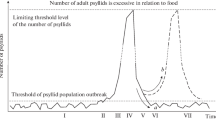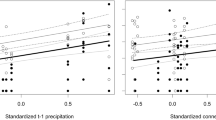Summary
A stochastic model of western tent-caterpillar populations on southern Vancouver Island was used to assess conditions leading to outbreaks. Three qualitatively different populations-declining, minimal, and recovering-were exposed to six-year climatic sequences incorporating various combinations of good, bad, and mediocre spring weather. Starting populations were either distributed randomly or concentrated in and around small-, medium-, or large refuges.
The results showed that virtually any type of population could temporarily increase in numbers during two highly favorable springs. Only a very few vigorous populations, however, could sustain the momentum required to surge to outbreak proportions. No low-quality population could do so. And even vigorous populations could not achieve outbreak status unless they were initially concentrated in a sufficiently large refuge that was close enough to potentially suitable habitats to permit rapid immigration into such places as soon as their local climates improved.
The concept of “climatic release” of insect populations is discussed in the light of these findings. The results demonstrate that climatic release is inextricably linked with a population's qualitative profile and spatial distribution.
Similar content being viewed by others
References
Allee, W.C., A.E. Emerson, O. Park, T. Park andK.P. Schmidt. (1949)Principles of Animal Ecology, W. B. Saunders, Philadelphia.
Berryman, A.A. (1978) Towards a theory of insect epidemiology.Res. Popul. Ecol.19: 181–196.
Boer, P. J. Den. (1968) Spreading of risk and stabilization of animal numbers.Acta. biotheor.18: 165–194.
Clark, L.R. (1964) The population dynamics ofCardiaspina albitextura (Psyllidae).Aust. J. Zool.12: 362–380.
Graham, S.A. (1939) Forest insect populations.Ecol. Monog.9: 301–310.
Greenbank, D.O. (1956) The role of climate and dispersal in the initiation of outbreaks of the spruce budworm in New Brunswick. I. The role of climate.Can. J. Zool.34: 453–476.
Holling, C.S. (1973) Resilience and stability of ecological systems.Ann. Rev. Ecol. Syst.4: 1–23.
Itô, Y. (1961) Factors that affect the fluctuations of animal numbers, with special reference to insect outbreaks.Bull. Nat. Inst. Agr. Ser. C.13: 57–89.
Ludwig, D., D.D. Jones andC.S. Holling. (1978) Qualitative analysis of insect outbreak systems. The spruce budworm and forest.J. Anim. Ecol.47: 315–332.
May, R.M. (1977) Thresholds and breakpoints in ecosystems with a multiplicity of stable states.Nature (London)269: 471–477.
May, R.M., G.R. Conway, M.P. Hassell andT.R.E. Southwood. (1974) Time delays, density-dependence and single-species oscillations.J. Anim. Ecol.43: 747–770.
Maynard-Smith, J. (1974)Models in ecology. Cambridge University Press, Cambridge.
Neilson, M.M. andR.F. Morris. (1964) The regulation of European spruce sawfly numbers in the Maritime Provinces of Canada from 1937 to 1963.Can. Ent.96: 773–784.
Readshaw, J.L. (1965) A theory of phasmatid outbreak release.Aust. J. Zool.13: 475–490.
Ricker, W.E. (1954) Stock and recruitment.J. Fish. Res. Bd. Can.11: 559–623.
Rogers, C.E., R.D. Eikenborg andK.J. Starks. (1972) A review of greenbug outbreaks and climatological deviations in Oklahoma.Env. Ent.1: 664–668.
Southwood, T.R.E. (1975) The dynamics of insect populations, inInsects, Science andSociety (ed. D. Pimentel). Academic Press, New York, 151–200.
Southwood, T.R.E. andH.N. Comins. (1976) A synoptic population model.J. Anim. Ecol.45: 949–965.
Takahashi, F. (1964) Reproduction curve with two equilibrium points: a consideration of the fluctuation of insect population.Res. Popul. Ecol.6: 28–36.
Thompson, W.A., P.J. Cameron, W.G. Wellington andI.B. Vertinsky. (1976) Degrees of heterogeneity and the survival of an insect population.Res. Popul. Ecol.18: 1–13.
Thompson, W.A., W.G. Wellington, I.B. Vertinsky andE.M. Matsumura. (1977) Harvesting strategies, control styles and information levels: a study of planned disturbances to a population.Res. Popul. Ecol.18: 160–176.
Uvarov, B.P. (1931) Insects and climate.Trans. Ent. Soc. London.79: 1–247.
Voûte, A.D. (1946) Regulation of the density of the insect populations in virgin-forests and cultivated woods.Arch. Néer. Zool.7: 435–470.
Wellington, W.G. (1954a) Weather and climate in forest entomology.Meteorol. Monog.2: 11–18.
Wellington, W.G. (1954b) Atmospheric circulation processes and insect ecology.Can. Ent.86: 114–127.
Wellington, W.G. (1962) Population quality and the maintenance of nuclear polyhedrosis between outbreaks ofMalacosoma pluviale (Dyar).J. Ins. Pathol.4: 285–305.
Wellington, W.G. (1964) Qualitative changes in populations in unstable environments.Can. Ent.96: 436–451.
Wellington, W.G. (1965a) The use of cloud patterns to outline areas with different climates during population studies.Can. Ent.97: 617–631.
Wellington, W.G. (1965b) Some maternal influences on progeny quality in the western tent caterpillar,Malacosoma pluviale (Dyar).Can. Ent.97: 1–14.
Wellington, W.G. (1977) Returning the insect to insect ecology: some consequences for pest management.Environ. Entomol.6: 1–8.
Wellington, W.G., J.J. Fettes, K.B. Turner andR.M. Belyea (1950) Physical and biological indicators of the development of outbreaks of the spruce budworm,Choristoneura fumiferana (Clem.) (Lepidoptera: Tortricidae),Can. J. Res. (D),28: 308–331.
Wellington, W.G., P.J. Cameron, W.A. Thompson, I.B. Vertinsky andA.S. Landsberg (1975) A stochastic model for assessing the effects of external and internal heterogeneity on an insect population.Res. Popul. Ecol.17: 1–28.
Author information
Authors and Affiliations
Additional information
Order of authorship determined by chance.
Rights and permissions
About this article
Cite this article
Thompson, W.A., Vertinsky, I.B. & Wellington, W.G. The dynamics of outbreaks: Further simulation experiments with the western tent caterpillar. Res Popul Ecol 20, 188–200 (1979). https://doi.org/10.1007/BF02512624
Issue Date:
DOI: https://doi.org/10.1007/BF02512624




